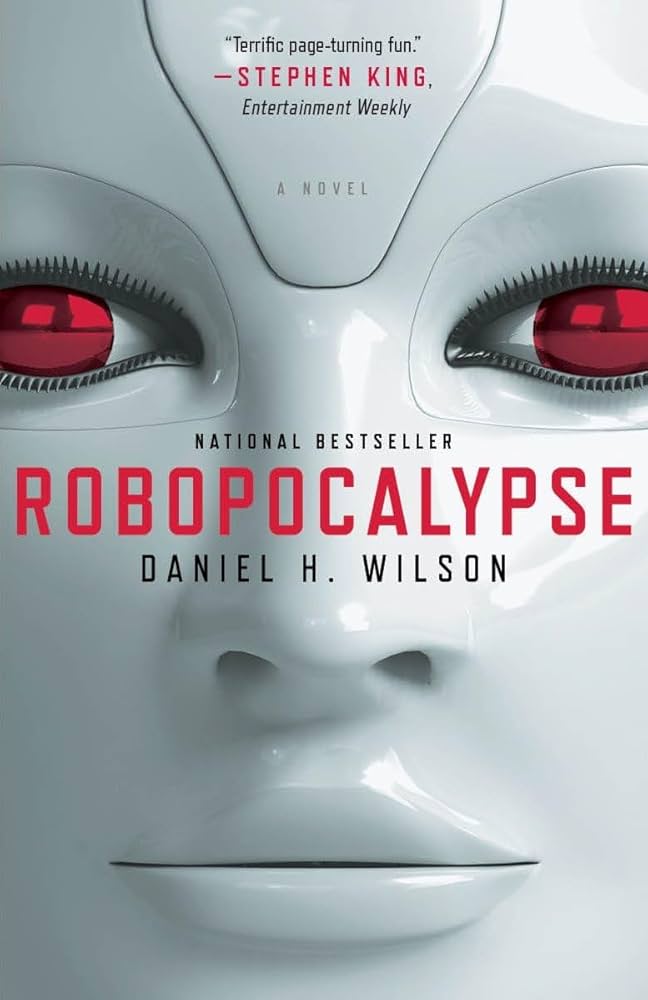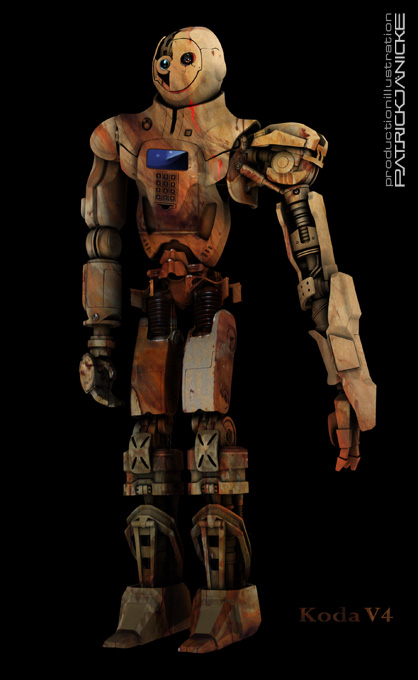YES! I’m finally reviewing it!
Genre: Sci-Fi
Premise: After the humans win the war against the robots, we get a highlight reel of the major moments that led to both the rise and fall of the machines.
About: Robopocalypse is one of the most famous properties ever purchased by Hollywood due to the fact that Steven Spielberg was announced as the director. The book was optioned in 2011. Drew Goddard was hired to adapt. Chris Hemsworth was hired as the male lead with Anne Hathaway in the main female role. The 200 million dollar film was scheduled to be released in 2012 by Disney. But Spielberg delayed it and then, a year later, left the project. The book’s writer, Daniel Wilson, to this day is hoping it makes it back onto some studio’s radar.
Writer: Daniel Wilson
Details: 350 pages

As I look back at Spielberg’s output over the last decade, I keep thinking of how it could’ve changed for the positive if he had directed Robopocalypse. The name alone screamed “GIANT SUMMER MOVIE” and felt like a perfect strike for the best mainstream director of our time.
So when he suddenly abandoned the sure-fire hit to send audiences into 2 hours of cryo sleep with Lincoln, I was disappointed. The funny thing is, I had no clue what the story for Robopocalypse was other than there was going to be a robot apocalypse. But that was the genius of it! It’s one of the great titles in title history, like “Monster-In-Law.” You knew EXACTLY what the movie was about just by hearing the title! It would’ve made hundreds of millions of dollars. Heck, it might STILL make hundreds of millions of dollars.
So I decided to finally read the book and do some detective work (along with some serious speculation) to discover why Spielberg may have left the project. And you know what? I think I figured it out. Before I share that with you, here’s a quick breakdown of the book.
We start out deep in the northern part of Alaska as soldiers dig out some sophisticated computer equipment from a giant hole in the ground. We’re told by soldier Cormac Wallace that the “New War” is over. The humans have defeated the robots. They are recovering the central computer, Archos, that controlled the attack. As a result, they will have all the major recorded events that led up to the war.
The book then is a “curation” of the most important events Cormac found in the hard drive. Everything from official interviews to events that security cameras caught on city streets are all on file. This allows the author, Daniel Wilson, to write a bunch of short stories. It is both the best thing and the worst thing about the book.
These stories include the first robot attack, which takes place in a convenience store where a robot bludgeons an employee to death. Another story follows a group of workers at a factory who play a prank on their weird older boss, kidnapping his love robot and bringing it to work, where it proceeds to attack the older man, biting his face off. We see the night in the city when all the cars – which are all computer controlled now – just start riding up on sidewalks, mowing down as many humans as possible.
My favorite story was when one of the main characters, a congresswoman, is driving her family to her father’s country house to escape the beginning of the war when she gets a call from her father to head to the Indianapolis Speedway instead. She then sees a pickup truck shooting towards her from behind and then it pulls up to the side of her momentarily and we see this woman inside, crying hysterically, banging on the windows for help. The car then shoots forward, steers into the oncoming lane, and plows into another car, each blowing up.
Our rattled mom then does a U-turn to head back to the new destination but meets a roadblock of another crash up ahead. There’s a man from one of the cars lying on the side of the road so she hurries out to see if he’s still alive. He’s dead. And his phone is in his hand. She hears a message from his wife. It says that she needs him to turn around and meet her at the Indianapolis Speedway.
Eventually, the book evolves into a semi-narrative (I say “semi” cause it’s still, essentially, a series of short stories) that follows the resistance and its eventual discovery of Archos’s location. The main regiment that Cormac is a member of teams up with some Native American soldiers and they head to Alaska, where they battle terrain that has been carefully prepped with robot defenses. A lot of people die but, as we already know, the humans win.
 Official Concept Art
Official Concept Art
There’s an obvious freedom that comes from not being tethered to a narrative. You can write any short story you want. This allows you to only write the best of the best stories to come out of the war. The problem is, when you don’t have a narrative that pulls it all together, when you don’t have a main character who is guiding you through it all, the reader starts to dissociate from the story. That’s because every time we, the reader, start a new chapter, we’re starting over.
If I had to guess, I’d say that’s the reason the movie didn’t get made.
The book gives you the concept but it doesn’t give you the narrative. As a result, you can go in any direction you want. You can tell the story from anybody’s point of view. While that seems tempting, you are then moving away from the book since you’re not including all of the short stories. What are you really adapting, then?
I bet that what happened was Drew Goddard did that first draft and it sucked because he had too much choice. He could do anything he wanted, which blinded him from finding the best angle. That draft was sent to Spielberg. He probably realized it was the wrong take. And Spielberg knows that good scripts take time. He ultimately decided not to invest that time. So the project was dropped.
Another problem is that the book starts with the war being over and the humans winning. I understand that they did this with the World War Z book as well but I think it’s a terrible way to go into a story. You have zapped any and all suspense the second you tell us who won the war. Why are we even reading then? It’s an odd storytelling choice that I’ll never understand.
And we saw that, in the script development of World War Z, after trying to utilize the original structure through several writers, they realized it was a stupid idea and decided to tell the story in chronological order instead. Which is what you need to do here. I don’t know if Goddard tried to do that on his first pass or not. But if he didn’t, there’s no doubt that’s the reason the draft sucked.
Just like any short story collection, the book works when the short story is good and doesn’t work when the short story is bad. Luckily, there are a lot more good stories than bad here.
There’s a terrifying plane scene where the onboard computers link two planes up to collide and the pilots have to desperately figure out a way to avoid it. There’s a horror chapter where a little girl’s toy bot becomes evil. There’s a story out in Afghanistan where an American and Afghani soldier must team up to take down a determined psycho robot. Wilson has a good eye for dramatically entertaining scenarios.
The only thing that annoyed me was that Wilson would occasionally cheat. For example, he starts out every chapter saying something like: “This event was recorded by a series of public cameras and the sound was recorded by numerous nearby cell phones.” He would then write the story like this: “John had a lump in his throat the size of the Grand Canyon. He was never good with pressure but now he didn’t have a choice.” How is it that public cameras and recording cellphones know that John had a lump in his throat and was really nervous? That makes no sense.
It’s not a huge thing but if you’re going to create these rules to your story – where you’re pretending that all of this was available due to public recordings – you can’t change those rules in order to write descriptive prose. You have to treat it like it’s just the facts. Unless you want to break the suspension of disbelief.
But look. They should still make this movie! With the fast rise of AI, the subject matter is more relevant than ever. All you need is to get a good director and a good writer to read the book then sit down for an 8-hour brainstorming session where you hash out what the best story angle is. There are a dozen angles that could work. Then you go write the thing. I could have a draft for you in a month if you want.
[ ] What the hell did I just read?
[ ] wasn’t for me
[x] worth the read
[ ] impressive
[ ] genius
What I learned: My approach to adapting something like this would be to write down all of the scenes in the book that you could imagine would make great movie moments, the kind of images or scenarios that you would see in a trailer. For example, that scene of the woman trapped in her truck banging on the windows crying to get out as it passes our protagonist’s car – that’s a trailer moment right there. It totally sells the movie. Come up with as many of those as possible and then see if there’s a version of the story where you can include them all. If you can’t find one, then find one that includes MOST of them. If you still can’t find one, find the idea that incorporates as many of them as possible. Cause those moments are your film-sellers. So that’s what you want to build your story around.

